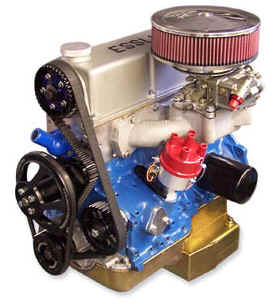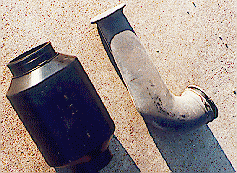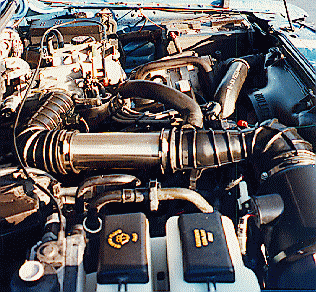What Size Engine Can Replace a 2.5 Liter 2001 Ford Ranger Engine
| These motors are commonly referred to equally either the Lima or merely the 2.0, 2.iii or two.v OHC (Over Head Cam) engines. They started life based on the High german designed 2.0 EAO sport motors that were first introduced to this country in the Mercury Capri�s from the early on 1970�southward. They share nil with the two.3 - 2.5 liter HSC motors that were offered in the passenger car line from 1984 - 1991. The ii.3 commencement debuted in the 1974 Pinto using a progressive 2bbl Weber/Holley carburetor and a points distributor. In 1975 they were upgraded to a Duraspark ignition system. They remained unchanged until about 1981 when the intake ports were changed from an oval to a 'D' shape (apartment flooring). The 2.0/two.3 liter versions that were offered in Rangers starting in 1983 used a unlike head having 4 evenly spaced round holes of equal size. A two.0 liter 1bbl carbureted version was offered in Rangers from 1983 - 1985, and in 1987 - 1988 with a 2bbl carburetor in some parts of the Us, Canada and Mexico. Electronic Fuel Injection (EFI) was added to the engines in 1985. In 1989 the 2.3 was changed to a DIS (Distributorless Ignition System) ignition utilizing a new 8-plug head ( 2-plugs per cylinder). This head had larger evenly spaced D-shaped intake ports and was used until the end of production of the ii.v in 2001. The ii.5 liter version was only offered from 1998 To 2001, when the engine was replaced by a 2.3 liter DOHC Duratec based engine. The 2.v was a stroked (by vii mm) version of the 2.iii OHC Ford Ranger engine. It besides used higher-menses cylinder heads for meliorate intake and combustion. It was replaced in 2001 by the Mazda-derived Duratec 23. In 1979 - 1981 a high pinch draw thru carbureted turbo version of the 2.three was offered. In 1983 - 1988 a lower compression EFI turbo version was offered in T-birds, Cougars, Mustang SVOs and Merkur XR4Ti�s (through 1989). Some of the changes to the motor over the years were:
Firing Orders: 2.0L and 1983 - 1988 2.3L Engines Firing Guild: 1-3-four-2 Benefactor Rotation: Clockwise 1989�1997 ii.3L / 2002-2011 2.3L Duratec / 1998-2001 ii.5L Engines Firing Order: 1�three�iv�two Distributorless Ignition Differences between major engine parts are every bit follows: Blocks: The 2.0 is an underbored 2.3. With the exception of the bore, the blocks are identical to all two.3�s 1975 - 1988 2.3�s are interchangeable 1989 - 1994 2.3's are the same equally the 1983 - 1988 2.3�s but have a smaller main journal saddle. The oil pan seal surface was changed in 1987 to eliminate the (4) piece seal and holes were added in the forepart to bolt on the DIS�s creepo trigger assembly. 1995 - 2001'south are similar to the 1989 - 1995�southward but a Cam Position Sensor was added behind the aux sprocket. The hole for the distributor was eliminated and the oil pump was moved in place of the aux. shaft itself. Turbo blocks are identical to the 1983 - 1988 Ranger blocks but have an additional boss with a hole threaded in the passenger side about � manner back that provides a place to drain the lubricating oil back into the engine from the turbo. Cranks: ii.0 and early 2.3 cranks are identical. Late 2.3 cranks take smaller main journals. 2.5 cranks are identical to two.3�s except they take a longer stroke. Rods: 2.0 and 2.3 (including turbo) rods are identical up through at to the lowest degree 1994. In fact they still have the original D4 (�74) casting number on them. Pistons: The 2.0 pistons are unique and don�t interchange. The 2.3 pistons are nonetheless excluding the turbo versions which were forged. Low compression (8.0:1) in the 1983 - 1888�s and loftier compression (9.0:1) in the 1979 - 1981�s. The 2.5 pistons are similar to the two.iii�south merely take a unlike wrist pin height. Heads: All two.0/2.3/2.5 heads will physically bolt in identify of each other. They all have similar exhaust port shape and placement. All cams are interchangeable as long every bit they are used with the proper followers. Subsequently model (1995 and newer) roller cam followers cannot be hands swapped onto an older head as the valve stalk size was reduced in the newer heads and matching slot in the follower was reduced. Early two.0 and 2.three heads take the same small-scale circular intake ports spaced evenly apart. They differ from each other in their valve sizes though. Caput Variations: There are several variations on the 2.iii heads though they pause down into (4) distinct types: i) Passenger car oval port heads - 1974 - 1980 Mustang, Pinto, Fairmont, Bobcat, etc. 2) Rider car D-port head - 1981 - 1995? T-bird, Mustang, Etc. 3) Truck round port - 1983 - 1985 Ranger four) Truck D-port - 1989 - 2001 Ranger. The 1989 - 1994's and 1995 - 2001's accept different combustion chambers and ports. It is thought that the newer head is better designed. Part Numbers: The following parts and information are from the Federal Mogul website. The function numbers are theirs and are Sealed Power numbers. Those in parenthesis are: FP = Fel-Pro, FM = Federal Mogul
Performance Parts: If yous're looking for performance parts, yous should check out these sites: Esslinger Engineering They have been a dominating force in four-cylinder Ford performance products for over thirty years. They produce engines and products that accept powered everything from off-road trucks and midgets to ministocks and hydro-planes. Along the way, they accept helped customers accomplish countless wins and championships. They specialize in single overhead cam 2.three and ii.0 liter Ford engines. They provide hundreds of operation products, including consummate engines, short blocks, Aluminum cylinder heads, pulley kits, oil pans, carburetors, manifolds, crankshafts, cams, distributors and almost everything imaginable. Camcraft They have a selection of cams for nearly engines establish in the Ford Ranger & Bronco vehicles including the two.0 and 2.3. Race Engineering Race Engineering specializes in racing and high-performance internal engine parts. They specialize in forged pistons, forged connecting rods, barracks connecting rods, crankshafts, piston rings, gaskets, MLS gaskets, race bearings, camshafts, valves and valve train components. Counterbalanced rotating assemblies are carefully engineered for nigh all engines. We take developed a series of assemblies (including strokers) for four cylinder Ford motors (2.3, 2.5 & stroker Ford 4 cylinders for oval runway/mini stock). Racer Walsh Racer Walsh carries numerous 2.0 and two.3 parts. NeedHP.com Check them out for a variety of Ford iv-cylinder parts. Kurtz Kustomz Kurtz Kustomz carries the Truthful-Rev Max Induction kit which allows your engine to breathe more air by eliminating all of the power robbing restrictions associated with the stock organization, resulting in more than horsepower, amend low end torque, crisp throttle response, and overall increased efficiency. This is a complete bolt-on kit that replaces your stock airbox assembly. Speedwaymotors.com Speedway Motors carries Ford 4-cylinder parts. Modifications: Air Muffler: Start off with an improved air intake to let the engine breath improve. Beneath left you can run into the Air Muffler and the baffle. The air muffler (on the left) goes between the air cleaner and the throttle trunk. The baffle to the correct of it comes off the front end of the air cleaner within the body of your Ranger above the wheel well. Equally you can encounter in the picture below right, the air muffler was replaced with a piece of stainless but you tin can use PVC pipe. This will allow more air menses into your motor, increase HP, and make your motor a petty chip louder. Your air cleaner is in two (2) parts; air cleaner canister, and mass air flow sensor. Open your air cleaner and remove the air filter, and so unbolt the can in which the filter was in, when y'all pull the can off, the bamboozle will be attached to it. Remove the baffle, and reinstall the air cleaner. This will add more air period, HP, and audio to your Ranger.
One thousand&North offers an AirCharger replacement air intake for 1995+ 2.3 Rangers Porting : Port your upper and lower intake. The intakes don't line up diameter to diameter. Porting opens this up and allows better flow. Knife edge the intake side of the throttle body to remove the front lip. You can use a Dremel tool to grind, sand and vitrify this area to obtain a smooth airflow in to the engine. Y'all tin also manufacturing plant down the butterfly to blend in to the shaft for a smoother air flow. For details on how to port your heads, click Hither Ignition: Accel - Makes a ringlet pack for 1998 - 1999 Ford 4-cylinder. For more than information click Hither. MSD - Manufactures a DIS ignition system forth with wiring harnesses. Find their parts at Summit Racing. JetChip - Makes a module to reprogram the engines calculator. Click Hither Frazzle: Pacesetter offers headers for the 2.3 HERE. Dynomax and Gibson make true cat-dorsum exhaust systems for the Ranger. Turbos: You lot can bandy in a turbocharged iv-cylinder instead of trying to adapt a turbo to your engine. For info on turbo engines see Turbos . For info on the swap wait Here. Better Gearing: If our looking for more low cease torque, upgrade your rear gears to a lower (numerically higher) ratio. Electric Fan: Flex-A-Calorie-free makes a replacement fan for the Ranger and then you can supervene upon your clutch driven fan to reduce drag on the engine. What Others Accept Done: 'Odysseus' - I recently had some trouble with the truck bucking sporadically, or when it rained. The EGR valve was sticking. I removed the hose that comes out from the fuel injector to the valve and plugged it with an ink pen. Cleared it right up. I really noticed it has a little more ability likewise. Only trying to save yous guys some problem. | |||||||||||||||||||||||||||||||||||||||||||||||||||||||||||||||||||||||||||||||||||||||||||||||||||||||||||||||||||||||||||||||||||||||||||||||||||||||||||||||||||||||||||||||||||||||||||||||||||||||||||||||||||||||||||||||||||||||||||||||||||||||||||||||||||||||||||||||||||||||||||||||||||||||||||||||||||||||||||||||||||||||||||||
Source: https://www.therangerstation.com/tech_library/4cylinders.shtml







0 Response to "What Size Engine Can Replace a 2.5 Liter 2001 Ford Ranger Engine"
Post a Comment